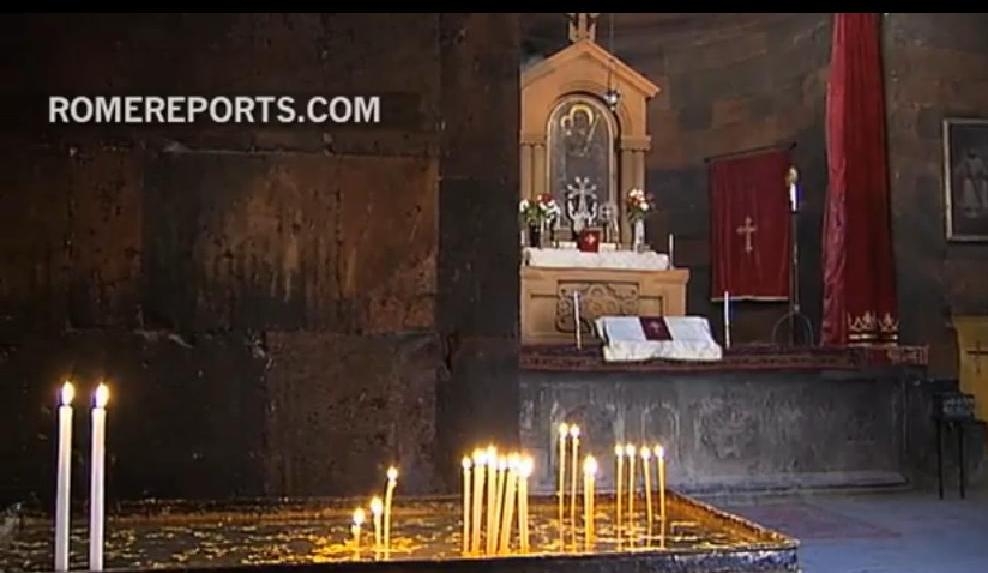Exhibition dedicated to St. Gregory the Illuminator launched in Vatican
 15:27, 17 October 2013
15:27, 17 October 2013YEREVAN, OCTOBER 17, ARMENPRESS. The exhibition dedicated to the life and deeds of the St. Gregory the Illuminator has appeared in the centre of the Italian media’s attention. The exhibition opened in the exhibition is titled "St. Gregory the Illuminator: Connecting Armenia to its Christian roots and to the Vatican". As reports "Armenpress" citing the official website of Rome Reports, the black and white photographs, are much more than just artistic shots. They make up a photographic biography of St. Gregory the Illuminator. This exhibit in Rome shows both his life and his deeds.
The Assistant to the Ambassador of the Republic of Armenia to the Holy See Vardan Karapetyan stated: "There are so many St. Gregories in the Catholic Church, but the surprise will be to discover the Armenian St. Gregory. There is a second part of the exhibit that focuses on the dissemination of his relics. The presence of St. Gregory in Constantinople, Rome, Nardò and so on."
Veneration of St. Gregory is present in both the Armenian and Catholic Church. In fact, there's a statue of St. Gregory, in the Vatican, on an exterior wall of St. Peter's Basilica. Back in the year 2000, John Paul II donated some of St. Gregory's relics to Armenian 'Catholicos.'
Through this exhibit the Armenian Embassy to the Holy See is not only celebrating the legacy of St. Gregory, but also a new chapter in its diplomatic relations with the Vatican. In the summer of 2013, Armenia issued its first resident ambassador to the Holy See. It's a connection that in a way, traces back its roots, to the evengelization and legacy of St. Gregory the Illuminator.
The Armenian St. Gregory is remembered for his role in converting the nation to Christianity back in the year 301. In fact, Armenia became the first nation to adopt Christianity as its official religion.
But getting to that point wasn't easy. During a pagan ritual, the king discovered that Gregory was Christian. As punishment he was tortured and sent to this underground well where he lived for over a decade. After miraculously healing the king, he was set free.
Gregory was the son of the Armenian Parthian nobles Anak the Parthian and Okohe. His father Anak, who was a Prince said to be related to the Arsacid Kings of Armenia or was from the house of Suren-Pahlaw, one of the seven branches of the ruling Arsacid dynasty of Bactria. Anak was charged with assassinating Khosrov II, one of the kings of the Arsacid dynasty and was put to death. Gregory narrowly escaped execution with the help of Sopia and Yevtagh, his caretakers. He was taken to Caesarea in Cappadocia, where Sopia and Yevtagh hoped to raise him. Gregory was given to the Christian Holy Father Phirmilianos (Euthalius) to be educated and was brought up as a devout Christian.
On the coming of his age, Gregory married a woman called Miriam, a devout Christian who was the daughter of a Christian Armenian Prince in Cappadocia. From their union, Miriam bore Gregory two children, their sons Vrtanes and Aristaces. Through Vrtanes, Gregory and Miriam would have further descendants and when Gregory died, Aristaces succeeded him. At some point Miriam and Gregory separated in order that Gregory might take up a monastic life. Gregory left Cappadocia and went to Armenia in the hope of atoning for the crime by his father by evangelizing his homeland.
At that time Tiridates III the son of the late King Khosrov II, reigned. Influenced partly by the fact that Gregory was the son of his father's enemy, he ordered Gregory imprisoned for twelve (some sources indicate fourteen) years in a pit on the Ararat Plain under the present day church of Khor Virap located near the historical city Artashat in Armenia. Gregory was eventually called forth from his pit in c. 297 to restore to sanity Tiridates III, who had lost all reason after he was betrayed by Roman emperor Diocletian. Diocletian invaded and vast amounts of territory from western provinces of Greater Armenia became "protectorates" of Rome.
In 301 Gregory baptized Tiridates III along with members of the royal court and upper class as Christians. Tiridates III issued a decree by which he granted Gregory full rights to begin carrying out the conversion of the entire nation to the Christian faith. The same year Armenia became the first country to adopt Christianity as its state religion. The newly built cathedral, the Mother Church in Echmiadzin became and remains the spiritual and cultural center of Armenian Christianity and center of the Armenian Apostolic Church. Most Armenians were baptized in Aratsani (upper Euphrates) and Yeraskh (Arax) rivers.
Many of the pre-Christian (traditional Indo-European) festivals and celebrations such as Tyarndarach (Trndez, associated with fire worship) and Vartavar (Vadarvar, associated with water worship), that dated back thousands of years, were preserved and continued in the form of Christian celebrations and chants. In 302, Gregory received consecration as Patriarch of Armenia from Leontius of Caesarea, his childhood friend.
As St. Gregory grew old and became more involved in solitary life, King Tiridates III asked him to ordain his younger son Arisdagés a bishop, and to take him on as Gregory's assistant. Gregory had already retired by a.d. 325, when the Holy Council of Nicaea took place, and he sent his son Arisdagés in his place to participate in this first ecumenical gathering of bishops of the Christian Church. In his retired state, however, Gregory continued his pastoral work by preaching and writing homilies, employing a simple language so that people could understand.





















